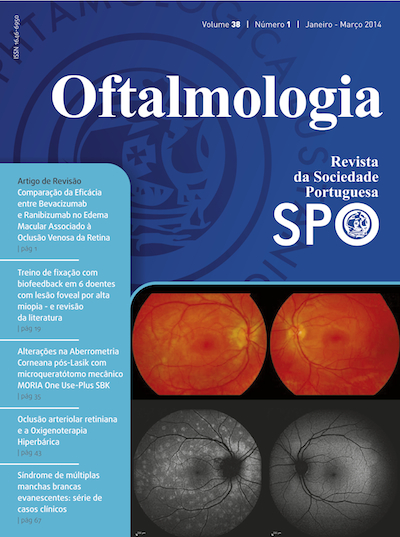Microperimetry in Central Serous Chorioretinopathy - Study of the fellow eye and affected eye after PDT
DOI:
https://doi.org/10.48560/rspo.5981Keywords:
Central serous chorioretinopathy, microperimetry, photodynamic therapy, macular sensitivity.Abstract
Aims: To find whether microperimetry (MP) detects changes of the fellow eye in Central Serous Chorioretinopathy (CSC); and to study the impact of photodynamic therapy (PDT) upon Macular Sensitivity (MS) of the affected eye. Study design: prospective, observational. Patients and methods: 28 patients with unilateral CSC and Best Corrected Visual Acuity of 20/20 in the fellow eye were included; and subdivided into a Past CSC (OCT-assessed resolution for ≥ 6 months) and an Active CSC Group. MP of the central 10o was performed in both eyes. A control group of 18 eyes (18 individuals) was assembled. Results: Active and Past CSC groups were composed of 4 and 24 patients, respectively. MS in the study group overall was 18.46 +/- 1.28 dB; and 18.77 +/- 1.28 dB in the control group (p=0.305). In the Past CSC group, the difference between MS in the fellow eye (18.5dB +/- 1.2 dB) and affected eye (15.1 +/- 3.2 dB) was significant (p < 0.0001). This difference was still evident in those who recovered 20/20 vision (p = 0.005). The MS gap between fellow eye and CSC eye was not signi- ficantly different (p=0.275) between the PDT group (2.90 +/-2.77 dB) and the group that was not treated (4.23 +/- 2.78 dB). Conclusions: Our study did not reveal subclinical changes in the fellow eye of CSC patients. CSC apparently produces a lasting lesion to the macula, even when visual acuity recovers. PDT may not help decrease the impact of CSC.
Downloads
Downloads
How to Cite
Issue
Section
License
Do not forget to download the Authorship responsibility statement/Authorization for Publication and Conflict of Interest.
The article can only be submitted with these two documents.
To obtain the Authorship responsibility statement/Authorization for Publication file, click here.
To obtain the Conflict of Interest file (ICMJE template), click here





